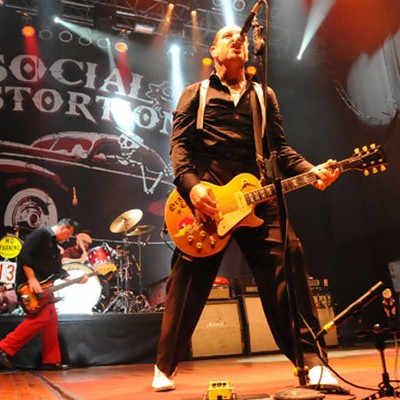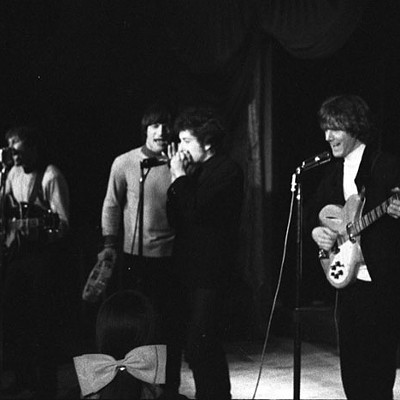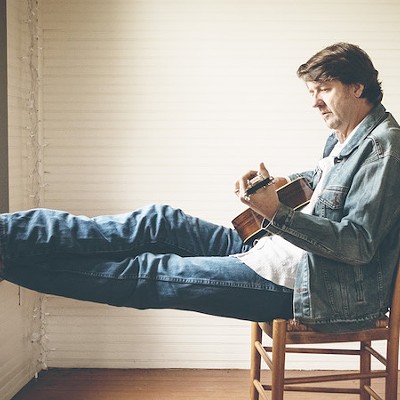We all witnessed that again early last month with the sudden departure of Lauren Oakes. After working as the club's primary sound engineer under Pegstar, the Houston promoters who had been leasing Fitz since July 2010, Oakes was appointed GM when Pegstar left to focus on building White Oak Music Hall, the multi-stage facility now under construction about two miles away on the banks of White Oak Bayou. A new group of investors quickly took over the Fitz lease and promised a thorough overhaul of the aging club, but differing opinions about the speed and scope of those renovations caused Transmission Entertainment, the Austin-based promoters who had agreed to act as primary booking agents for Fitz, to either back out of the deal or put it on hold (last we heard, the club said negotiations were continuing); either way, Oakes was gone shortly thereafter.
This is all old news by now, but the point is that both the articles announcing Oakes' appointment as GM and her departure were among the Press' most-read music-related articles of the past three months, if not Nos. 1 and 2. Things seem to have settled down somewhat in the past few weeks, but what happened was just the latest chapter of a story that dates back almost 40 years, and in some ways much longer than that. Besides the drama inherent in Houston's most recognizable music venue — albeit one that has undergone a slew of aesthetic tweaks over the years — attempting to modernize enough to remain viable in an ever-more-competitive live-music market, the real story is how Houstonians feel very proprietary about the old club on White Oak Drive. And why wouldn't they?
“The essential feature of a landmark is not its design, but the place it holds in a city’s memory,” New York Times architecture critic Herbert Muschamp wrote in January 2006, as quoted in an article on the Preservation Leadership Forum's Web site nearly eight years later. “Compared to the place it occupies in social history, a landmark’s artistic qualities are incidental.”
The building that houses Fitzgerald's will be 100 years old in three years. Posted a decade ago in the Houston Architecture Info Forum, this description of its time as a meeting hall for Houston's Polish-American community, which lasted from the end of WWII to the mid-'70s, could easily apply to the 35-plus years it has been utilized as a nightclub. “There was no air-conditioning, but the second floor had lots of windows and a good wood floor,” it begins.
The second-floor hall still opens to the outside porches, where sitters and standers can still take a break from the dancing inside. Wanda Bench, a Chappell Hill Pole/Czech and longtime supporter of the Polish Home, recalls large "war years" Christmas parties in the original hall, cooking the turkeys and trimmings on the first floor and carrying everything upstairs to the packed hall. Like many other Texas Poles, the young (and single) Wanda sought out the Home as a place of familiarity and comfort, attending the dances, bingo and other events with cousins and friends.
A persistent rumor is that Elvis Presley, who stopped in Houston frequently during his rise to stardom in the mid-1950s, played the building. Hard proof is hard to come by, so it probably didn't happen; however, Scotty Moore, the King's guitarist during those years, later wrote a long chapter about Houston on his Web site that refers to Polish Hall as one of the “leading Houston venues.” (So who knows…maybe he did.) Just two entries above Gilley's, a listing in the October 1978 issue of Texas Monthly describes the venue, which at that point would have been open as Fitzgerald's somewhere in the neighborhood of a year, this way:
The old Polish Hall in the middle of the Heights has been revamped and now serves as a showcase for local talent ranging from progressive country to jazz. A basically beer-drinking crowd in a barnlike setting. Soloists and duets play weeknights downstairs; the concert room upstairs handles larger crowds for weekend show groups.
Soon enough, the bingo matches and Sadie Hawkins dances gave way to names like Lightnin' Hopkins, Townes Van Zandt, Stevie Ray Vaughan, Tina Turner and James Brown. In the single month above, November 1987, you'll see Steve Earle, X, Fishbone, Alex Chilton and John Mayall, but also Austin's Monster Zero, featuring future Flaming Lips drummer Steven Drozd, and (coming in December) the Texas Outlaw Comics, a group of renegade Houston funnymen whose pedigree you can see below in this excerpt from the Rice Thresher:
Local musicians of all stripes have come to regard Fitzgerald's (which still has the same phone number) as almost sacred. Also in the calendar above, you'll notice the name of Jerry Lightfoot, the late beloved bluesman widely known around town as Houston's No. 1 “blue eyed soul brother” when he was alive. Lightfoot probably played every stage in Houston that had a halfway decent PA, but Fitz is where he picked to celebrate his 55th birthday in early September 2006. That's the show Rick Mitchell, one of two pop-music critics for the Houston Chronicle in the '80s and '90s, remembers. It turned out to be the last time he saw Lightfoot alive.
Lightfoot got most of the survivors from the Houston blues scene, black and white, to come out and jam, and Jerry sat in with all of them. Rocky Hill opened, then Grady Gaines and the Texas Upsetters, then Jerry's band with Carolyn Wonderland, Trudy Lynn, Tommy Dar Dar, Pete Mayes and others. It was a great night — excellent music, and good vibes all the way around. I was there with my old friend Marty Racine – both of us had left the Chronicle by this time, so we were not working. We just wanted to hang out with our man Foots and listen to the blues.
There were other places where the gig could have been held, but Fitz was the right choice. It's where the memories were. The next day Jerry went to Austin to play a gig before heading back home to Florida. A couple of days later, he was admitted to Brackenridge Hospital in Austin under somewhat suspicious circumstances with a serious head injury. Apparently, he either fell or got mugged. He died of his injuries a week or so later.
Between the two, Mitchell says Racine is the one who had Fitz as part of his “beat,” though both men made the club an off-the-clock headquarters of sorts. We asked Racine, now enjoying retirement in New Mexico, to send us his thoughts on the place and got back a bit of poetry.
Having arrived in Houston in 1981, I always divided the history of Fitzgerald’s into three epochs: B.C. (Before Chronicle), the roots-rocking ’80s and, to this day, the post-metal grind of the all-ages scene.
From my perspective, the first era, diverse as it was, is one of tales: How the homey building was once the Old Polish Dance Hall — I envision jovial immigrants hoisting mugs of Pilsner to the merry tweet of billowing accordions; how, since Sara Fitzgerald took ownership four years before my time, it morphed into a rough-and-tumble urban honky-tonk in a sketchy part of town— one story has it that one fair evening a patron was shot on the sidewalk. Or maybe he was stabbed. Details, details…
Despite management changes and shifting musical trends, the third era spans a continuing vibe toward under-21 pursuits (Generation Z? Generation A?). Soon enough, this thirtysomething geezer checked out of the Fitz he knew and loved.
Ah, but those ’80s. So quickly they came and left us, in a string of cherished, dreamlike nights passing through the tendrils of rock and roll — the tension and release of the blues, the slippery rhythms from black bayous, the rockabilly twang hopping a freight from Lubbock to Fort Worth to…Houston. It put this town on the map in esteemed circles. And somewhere in the darkened audience, the music critic recharged his soul and became a Texan forever.
This next part should be fun. One afternoon last month, I pulled down some bound volumes of the Houston Press off the shelves at five-year intervals dating back to October 1990, about as far as they go, and scanned the Fitzgerald’s ads. These are a few of the shows that leaped out.
OCTOBER 1990
The Kick/The Wackadoos; The Missiles/The Candidates/Mulberry Jane; Toy Subs/Mr. Know It All/Midnight Carnival; Wild Peach/Venus In Furs
OCTOBER 1995
Pushmonkey/Tumble Down; Feed Lucy/Pitch Fizzy; Aftershock/Elsie; Toadies/Hi-Fi & the Roadburners/Southern Backtones; Taste of Garlic/Dinosaur Salad/Quickserve Johnny; de Schmog/Ground Turkey/Fleshtug
OCTOBER 2000
Middlefinger/Brown Whornet/Groceries; Mighty Mighty Bosstones/Flogging Molly/Sum 41; Moses Guest; 7 Seconds/Against All Authority; Poor Dumb Bastards; Galactic; Jimmy Eat World; Zydeco Dots; Agnostic Front
OCTOBER 2005
Members of Cypress Hill & P.O.D.; Rhenium/Melovine/Neverset; the Radiators; Feeding James/Severin; Dine Alone/Spiracelli; “Joe's Roadhouse” w/Kenny Cordray & Mighty Orq; 30FootFALL/Middlefinger; Pasty White Boys/Fired For Walking/Stalking Chloe; Bobby Blue Bland
OCTOBER 2010
Peelander-Z; Warpaint; Foals; Portugal. The Man; Electric Six; Dawes; The Heavy; Best Coast
Some of those names have been lost to history, but many others — Venus In Furs, Toy Subs, Taste of Garlic, Dinosaur Salad, de Schmog, Middlefinger, Groceries, Southern Backtones, Moses Guest — were once perched on the top rung of the Houston music scene. Most twentysomethings would easily recognize Foals, Dawes and Best Coast at least. For the Gen-Xers, look at that Toadies bill back in ’95; the Bosstones/Flogging Molly/Sum 41 in 2000; or Jimmy Eat World that same month, shortly before Bleed American made them huge; or, for the even older folks, the valedictory lap by Bobby Blue Bland five years later. Other acts, like the Zydeco Dots, Mighty Orq and Poor Dumb Bastards are still close at hand. 30FootFALL will be back at Fitz Christmas night, as usual.
Fitzgerald’s belongs on a short list that includes Antone's or Emo's in Austin; CBGB in New York; Tipitina's in New Orleans; the Double Door in Chicago; The Roxy and Whisky a Go-Go in L.A.; and Trees in Dallas. All those clubs helped define the live-music experience in their respective cities, becoming storehouses of collective memories, and Fitz has outlasted almost every one of them. The place it reminds me the most, though, is Austin's Liberty Lunch, both for its eclectic calendar and allergy to pretentiousness. Both buildings were much, much older, and both began their musical lifespans at around the same time, but Liberty Lunch was bulldozed at the turn of the millennium while Fitz has endured.
Although I have never been what you might call a Fitz regular, I have seen plenty of shows there, including the first one where its history really sank in. It was one night in 2009, late enough in the year that everything was done up in Christmas lights. Booked with his band the Boxmasters, Billy Bob Thornton brought out Billy Gibbons onstage, where stray thoughts began flickering into my head. I wonder how many times Gibbons has played there. I wonder who else has been on that stage. That night especially, the history of Fitzgerald’s seemed to be seeping from the walls.
However, the most personal Fitz show to me is one I have no memory of whatsoever. It was Sleater-Kinney offshoot Wild Flag in late October 2011, downstairs while Mastodon played up. On the way to work the next morning — probably running late, I'm sure — I had a heart attack on the Ensemble/HCC light-rail platform, and the review never ran. When I woke up in the hospital about ten days later, I found a reporter's notebook full of scribblings from the show; by the time I left the hospital, it had been misplaced. That was the only time I ever remember laying eyes on it, but I always wondered what had been written in there.
But unique Fitzgerald’s experiences like that are all too common in Houston, so ultimately any continuity comes down to its owner, Sara Fitzgerald. A realtor from Pearland who bought the club in 1977, she's never been one to mince words, a pragmatic outlook that has no doubt played no small part in Fitz’s longevity.
"The music biz to me," Fitzgerald told this paper in May 1999, "is cleaning up puke, fixing plumbing and getting rid of rowdy customers.”
Luckily, many bands who played for Fitzgerald have taken a more romantic point of view. "The upstairs is the best room in all of Texas," Linda Waring, former drummer of Miss Molly and the Passions – another of Houston's most popular bands in its day — said in the same article. "It's all wood. It has the best acoustics. It has warmth. And, for me, the way my drums sounded there...they just don't make 'em like that anymore.”
Maybe so, but Fitz is still plugging along. Current manager Josh Merritt, whose band used to play Fitz around the dawn of what the Chronicle's Marty Racine called the “all-ages scene,” echoed Waring's comments shortly after he took over in October.
“There's something about that building, the wood and everything,” Merritt said. “When you're upstairs and it's packed and everyone's jumping up and down, you can kind of feel the floorboards up and down, there's a vibe you don't get anywhere else.”
Funny how that vibe has remained intact even as Fitzgerald's has passed through so many different eras. No matter who happens to be running the day-to-day, today it's one of the city's most beloved brands, like Foley's Department Store or Finger Furniture used to be. Musicians know it, as do many folks who have ever watched a band on one of its two stages. But if local history has taught us anything, it's that Houstonians should never, ever take Fitzgerald's for granted, because one day it too could be gone.






